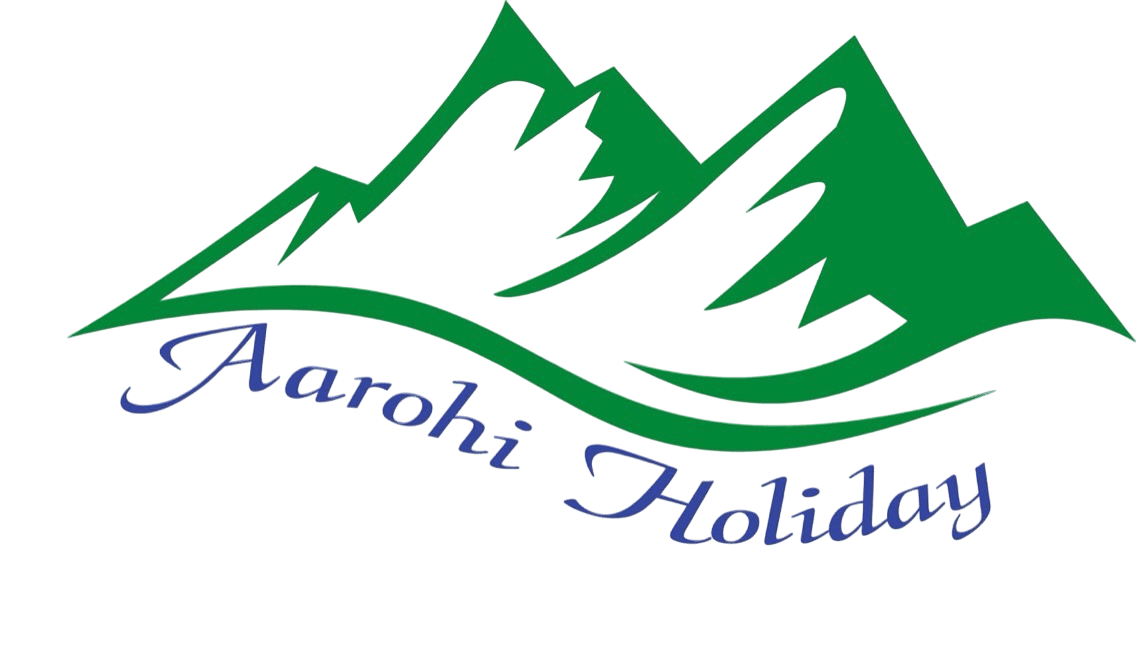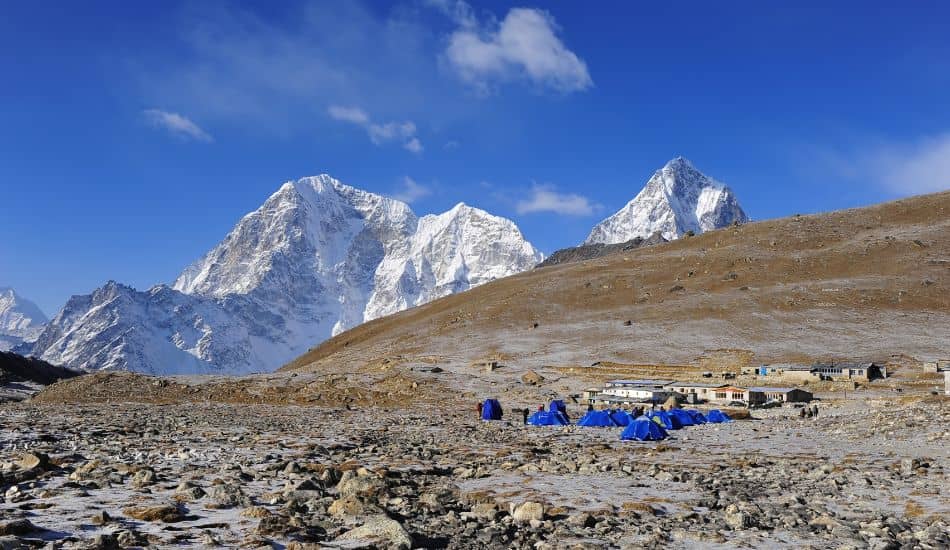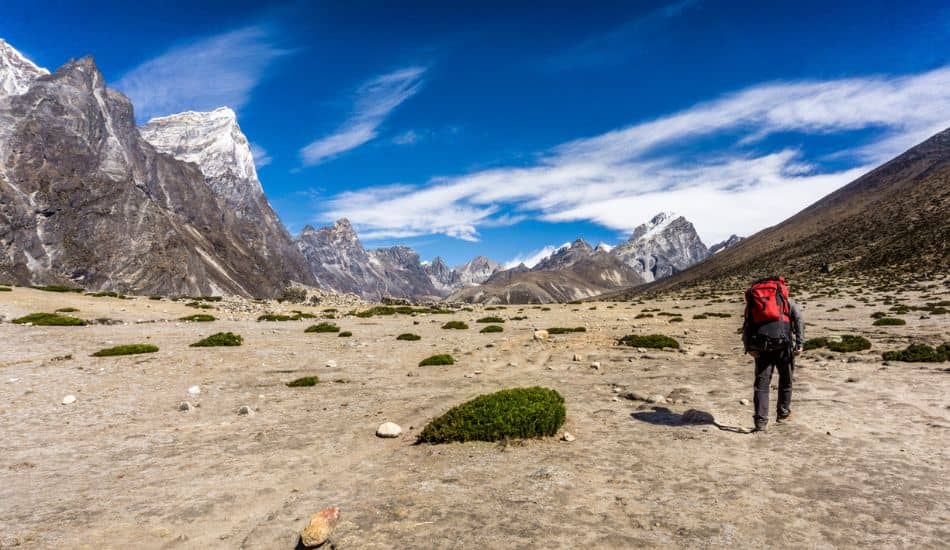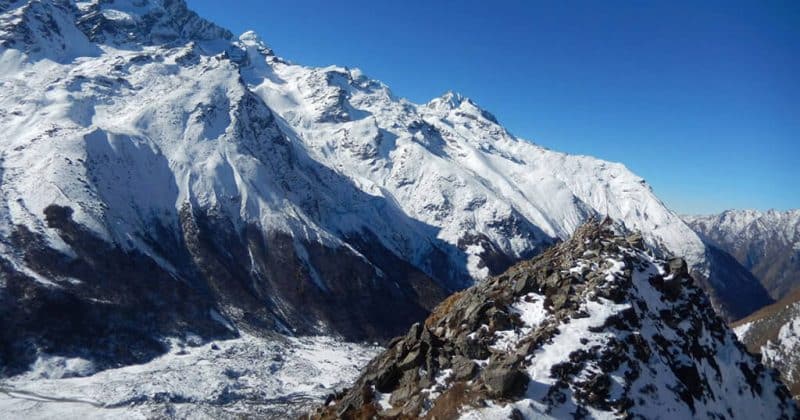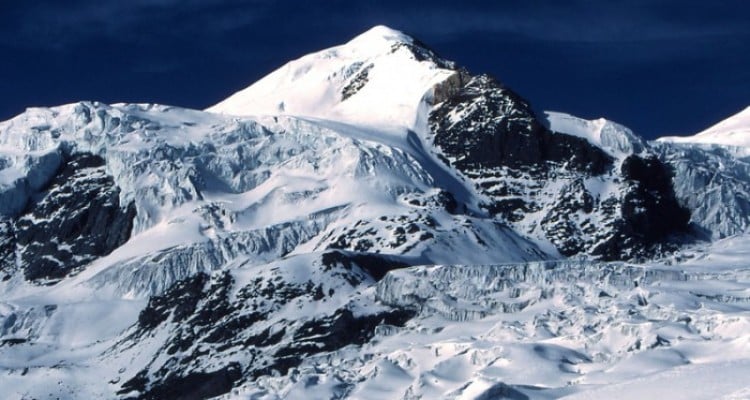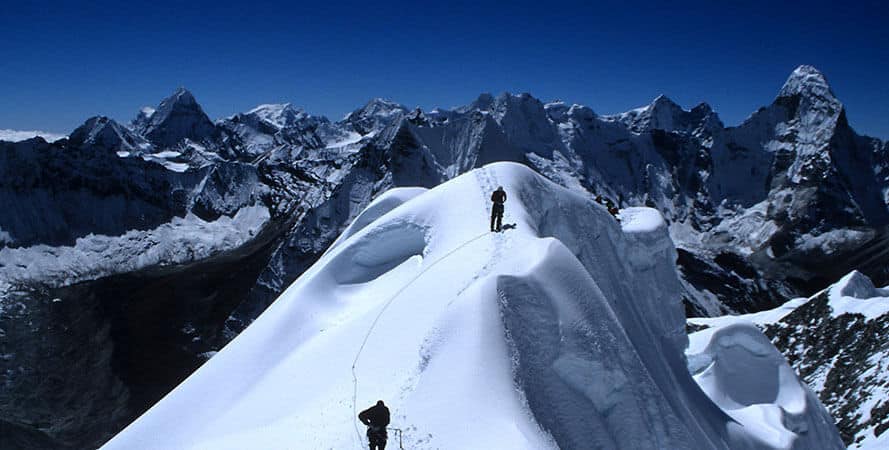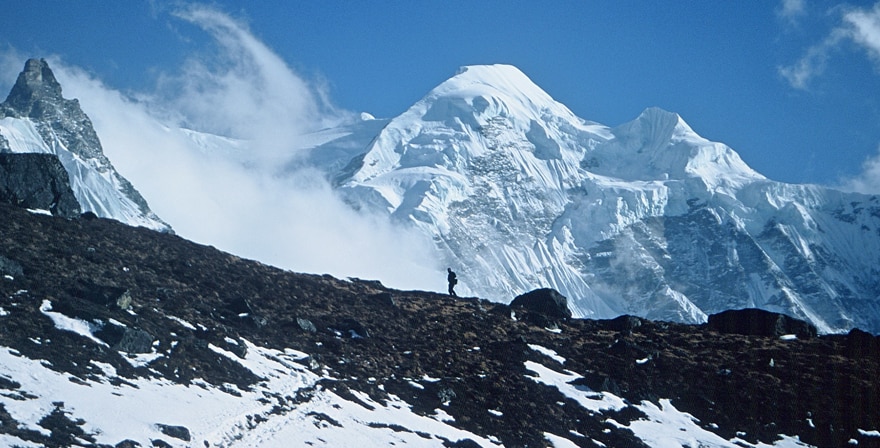Accommodation during Lobuche Peak Climbing
- In Kathmandu we provide comfortable accommodation in 3-star hotels with breakfast on a twin-sharing basis.(Private room accommodation can be arranged, at an extra cost)
- During the trek, we provide comfortable teahouse accommodation on a twin-sharing basis. Hot showers, Wi-Fi, and device charging are available at an additional cost.
- During the Climbing we provide high-quality alpine tents with all necessary camping gear.
Meals and Drinking water on Lobuche Peak Climbing
During the Lobuche Peak Climbing journey, you will be served three meals a day: breakfast, lunch, and dinner. On the trekking route, meals are provided in local teahouses, and during the climbing days, our crew prepares fresh and simple camping meals. Typical food includes dal bhat, Tibetan bread, momos, noodles, fried rice, soups, pasta, pancakes, and eggs. These meals are basic but filling, giving you the energy needed for trekking and climbing.
At Lobuche Peak Base Camp, hot meals are freshly prepared by our climbing crew using quality ingredients to keep you well-nourished at high altitude.
Staying hydrated is very important at high altitude. Bottled water is available at teahouses, but we encourage you to carry a refillable bottle to reduce plastic use. Our guides provide water purification tablets or drops so that you always have safe drinking water. Eating well and drinking enough water will help you acclimatize and stay comfortable during the climb.
Required Permits for the Lobuche Peak Climbing
For the Lobuche Peak Climb, you’ll need a few permits, but you don’t have to worry about arranging them yourself. All permit fees are included in our package, and we’ll take care of the paperwork so you can focus on preparing for the climb.
- Lobuche Peak Climbing Permit: USD 250 per person (spring), USD 125 per person (autumn), USD 70 per person (winter and summer)
- Sagarmatha National Park Entry Permit: NPR 3,000 per person.
- Khumbu Pasang Lhamu Rural Municipality Permit: NPR 2,000 per person
- TIMS Card cost: NPR 1000 per person
Best Time for Lobuche Peak Climbing
The best time for Lobuche Peak climbing is during the spring (April to May) and autumn (September to November) seasons. These months provide the most stable weather conditions, clear skies, and moderate temperatures, making them ideal for both trekking and mountaineering in the Himalayas. In spring, climbers can enjoy the blooming rhododendrons and mild post-winter weather, while autumn offers clear skies and excellent visibility after the monsoon season. These favorable conditions help minimize weather-related risks and enhance safety on the mountain.
Lobuche Peak Climbing Difficulties
Lobuche Peak Climbing is a demanding adventure that combines trekking in the Everest region with a high-altitude summit at 6,119 meters. The route involves long trekking days of 5 to 7 hours on steep and rocky trails, followed by climbing sections that require basic mountaineering skills such as using ropes, crampons, and an ice axe. The altitude is one of the biggest challenges, as you gradually ascend from Lukla (2,840 m) through Namche, Tengboche, Dingboche, and Lobuche before moving toward the high camp and summit push. Reaching these elevations carries the risk of altitude sickness, which is why acclimatization days are built into the itinerary. Our experienced climbing guides carefully monitor your health and maintain a safe, steady pace throughout the journey.
Weather can also add difficulty, with cold temperatures, strong winds, and sudden changes being common at higher altitudes. The final summit day is especially challenging, requiring physical strength, stamina, and mental determination. With the right preparation, proper acclimatization, and professional guidance, most fit trekkers with some prior high-altitude experience can successfully reach the summit of Lobuche Peak.
Altitude Sickness and Prevention on the Lobuche Peak Climbing
At Aarohi Holiday, your safety is our top priority, especially on high-altitude climbs like Lobuche Peak. Our climbing guides are trained in altitude sickness prevention, first aid, and emergency procedures. They carefully monitor every climber for signs of Acute Mountain Sickness (AMS) and follow a steady ascent plan that allows your body to adapt to the altitude.
Common AMS symptoms such as headache, nausea, dizziness, and fatigue are always taken seriously. If symptoms appear, our guides take immediate action with rest, hydration, and a slower pace. In more serious cases, descent or emergency evacuation is arranged without delay. Before the climb begins, you will receive a full safety briefing with clear guidance on how to recognize and manage altitude-related issues. With the right acclimatization schedule, proper hydration, and the support of our experienced team, you can approach the climb with confidence and focus on the rewarding experience of summiting Lobuche Peak.
Travel Insurance for Lobuche Peak Climbing
Aarohi Holiday strongly recommends that all climbers have comprehensive travel and medical insurance before attempting Lobuche Peak. The climb involves high-altitude terrain and remote areas where medical facilities are limited and emergency services can be difficult to access. Having proper insurance ensures you are covered in case of unexpected events during the climb.
Your insurance should be valid and specifically cover high-altitude climbing up to at least 6,200 meters. It must include personal injury, accidents, medical treatment, and emergency evacuation, including helicopter rescue if needed. With the right insurance in place, you can focus on the climb with confidence, knowing you are protected and supported by Aarohi Holiday throughout your journey.
Lobuche Peak Climbing Itinerary
The Lobuche Peak Climbing is an exciting high-altitude adventure that starts in Kathmandu, where you will have time to prepare and explore the city. From Kathmandu, a scenic flight takes you to Lukla, the gateway to the Everest region, and the trek begins with a gentle walk to Phakding. The trail continues through Sherpa villages, including Namche Bazaar, where you will acclimatize and enjoy local culture and mountain views.
As the climb progresses, you will trek to Tengboche and Dingboche, with acclimatization hikes to help your body adjust to the altitude. From Lobuche, you will visit Everest Base Camp and hike to Kalapatthar for stunning sunrise views. The route then leads to Lobuche Peak Base Camp, where you prepare for the summit attempt. After summiting Lobuche East Peak, you will descend to Pheriche, retrace your steps back to Namche Bazaar and Lukla, and fly back to Kathmandu. The itinerary includes contingency and leisure days, giving flexibility for acclimatization and rest while ensuring a safe and rewarding climbing experience.
Lobuche Peak Climbing Cost
The cost of Lobuche Peak Climbing varies depending on the season, group size, and service preferences. Our 18-day climb is priced at USD 2,550 per person, which includes all essential services from arrival in Kathmandu to the completion of the trek and climb. This package provides a safe, well-organized, and comfortable experience in the Everest region.
This price is based on a minimum of one person. For group bookings, we offer discounts ranging from 5% to 10%, and the group leader can join at no additional cost. With transparent pricing and no hidden fees, Aarohi Holiday ensures excellent value for a rewarding high-altitude adventure.
Important Notes for Lobuche Peak Climbing
- In high season, Lukla flights operate from Ramechhap, about 5–6 hours’ drive from Kathmandu. In low season, flights are usually from Kathmandu. We arrange all transfers as needed.
- A helicopter flight from Kathmandu to Lukla takes 40 to 50 minutes and costs about USD 600 per person. This is an additional service for those who want to save time or avoid potential flight delays.
- This itinerary includes travel by shared bus to Ramechhap. A private jeep is also available on request for an additional cost.
- Porters can carry up to 20 kg, but we recommend keeping your pack under 10 kg as one porter is shared between two trekkers. A duffle bag for your gear will be provided.
- Meals are included during the trek. Hot showers and device charging at teahouses or lodges are available for an additional cost.
- Meals and sightseeing entry fees in Kathmandu are not included.
- Drones require hard-to-get permits, so it’s best not to bring.
Flight to Lukla
Flights to Lukla operate from Kathmandu or Ramechhap, depending on the season. Flying from Ramechhap involves a 5 to 6 hour drive from Kathmandu followed by a 30 to 40 minute flight to Lukla. Himalayan weather can be unpredictable, and fog or strong winds may sometimes cause delays or cancellations. Early morning flights are usually the most reliable. We arrange all transfers and keep you informed of any changes. Helicopter flights are also available at an additional cost.
Fitness Preparation for the Climbing
Lobuche Peak Climbing is a high-altitude adventure that requires good physical fitness and stamina. The climb reaches over 6,000 meters and includes long trekking days and technical climbing sections. Regular walking, hill or stair climbing, and cardio exercises such as jogging, cycling, or swimming will help prepare your body. Strength training for legs, core, and back is also beneficial. With proper preparation and the support of our experienced guides, most healthy and active individuals can successfully complete the climb.
A Typical Day on the Trail
A typical day on the Lobuche Peak Climbing journey involves 5 to 8 hours of trekking and climbing on rugged trails, rocky paths, and high-altitude terrain. The day begins after a warm breakfast, followed by walking through Sherpa villages, pine forests, glacial valleys, and moraine landscapes. Elevation gains are gradual on trekking days and more challenging during climbing sections, with the summit day requiring careful use of ropes, crampons, and an ice axe. You will have rest breaks and a lunch stop to stay energized while enjoying views of Everest, Lhotse, Nuptse, and Ama Dablam. Each day combines trekking and climbing, offering both cultural experiences and the thrill of high-altitude adventure.
Arrival Instruction
Upon your arrival at Tribhuvan International Airport, our company representatives are stationed to welcome you to the country. We request you to carefully look for your name being held by our representatives following the events upon landing. The representatives are responsible to escort you to your hotel in Kathmandu. You will see men offering you to carry luggage and take you to your destination as you exit the airport. We request you pay no attention to these people and follow the designated representatives and follow their instructions. You will also need to keep an eye on your luggage and belongings to avoid any complications.
Nepal Visa Entry Procedure
For entry into Nepal, there are visa requirements everyone (except Indian nationals) must complete before being allowed to pass through immigration. This is for air travel as well as overland transportation. Most visitors may obtain a visa to enter Nepal, however, there are exceptions. Three options are available for entry
- 15-day single entry: US $30
- 30-day single entry: US $50
- 90-day multiple entries: US $125
Please have a passport valid for at least 6 months from the time of entry, and have cash ready, preferably in US dollars, though there are other currencies Nepal Immigration accepts. If you are entering via overland, you must have US cash and 3 passport photos. For arrival by air, the kiosks at the airport take your picture for you.
For the most up to date list of exceptions for visa on arrival or to obtain the most current visa information, visit the Nepal Department of Immigration website.

